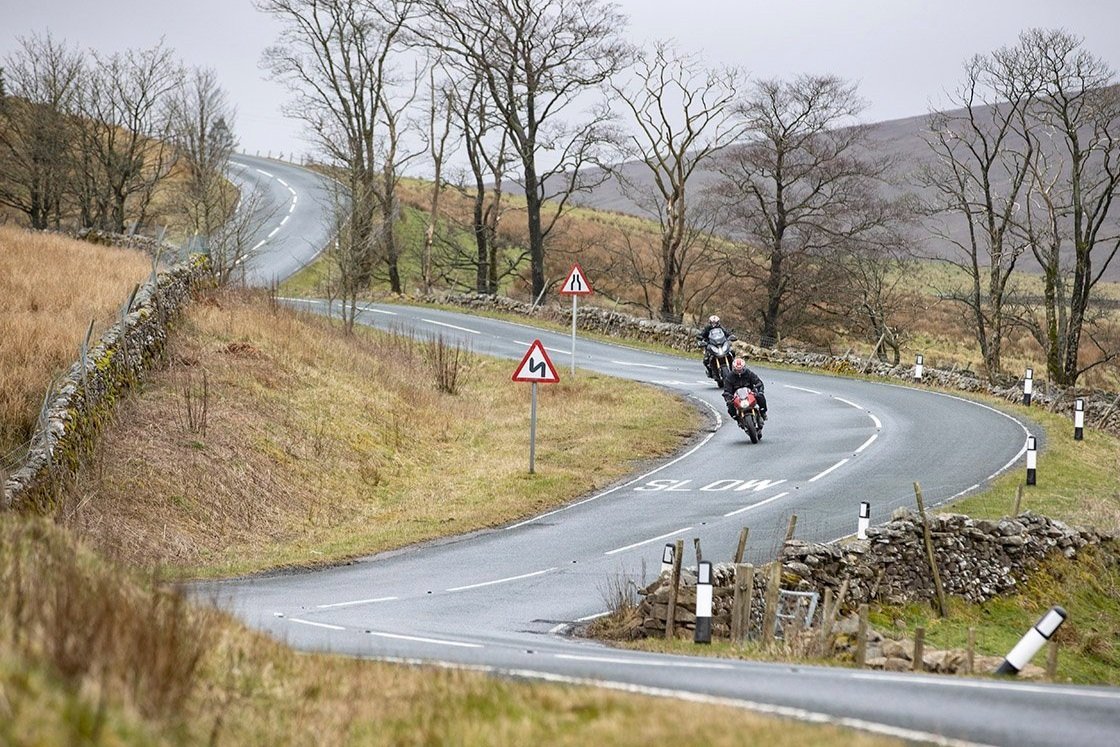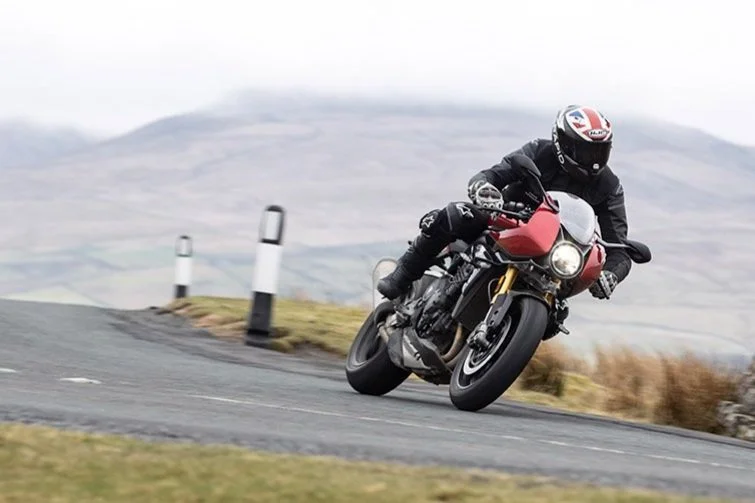SHARPEN UP FOR SUMMER
It’s usually the summer rides you remember forever, whether it’s chasing a sunset across the Yorkshire Moors, or feeling the air cool as hairpin after hairpin leads you higher into the Alps. But in many ways, your spring rides are far more important. They’re the foundations for a great summer and the ones where you get back up to speed.
Riding through the winter is an excellent idea because it keeps your riding brain ticking over – and can be great fun if you’ve got the right kit – but even the most hardcore of us won’t have leant a bike over much when the roads are cold. So now is the time to steal an hour here and afternoon there to shake off the rust.
The challenge is to fast-track your skills so your riding is rapid and safe by the beginning of summer rather than just about getting there as the nights draw in. That’s no easy task because the human brain starts ditching skills as soon as we stop using them, so what seemed like second nature last October can feel a clunky mess this May. But it can be done. Here’s how…
1. Be aware of skill fade
Everyone suffers from this. Red Arrows pilots are considered to have skill fade after a three-week lay-off so imagine the state of our machine control and road-reading after months of hibernation. To make matters worse, skill fade has been shown to affect those with fewer skills far more than experts – Marc Marquez might only take a few laps to get back up to speed after nine months off, but it’s likely to take the rest of us rather longer.
Not only that, but there are several areas where our skills can fade. Least affected are motor control skills which involve muscle memory – pushing the inside bar to turn in, for example. There will be some degradation in refinement, but we’re not going to forget how to ride. Mental skills suffer far more, so our ability to see and interpret the environment at speed can be seriously off. Obviously, that can lead to catastrophic errors in judging corner entry speeds and identifying hazards. This is the main reason why it’s worth planning what you do on your first few rides rather than just heading out for a blast.
2. Make it short and easy
The human brain uses roughly 20 percent of the body’s energy when we’re resting. There hasn’t been any research into how much it uses when we’re riding a high-performance motorcycle at a decent pace, but we’re guessing it’s a lot more than that. This explains why riding can be so utterly exhausting, even if we’re not physically doing very much – just processing all the visual information, assessing risks, working out plans, and spotting hazards takes a huge amount of energy. And if you’re out of practice, it’s going to be a lot more exhausting than normal, so your first few rides should be short and easy. Go out for an hour’s lap of mixed roads – the boring bits will give you time to relax and re acclimatise to your bike’s performance. And definitely don’t head off for a day in the Peak District (or Lakes, or Snowdonia etc) because there’s a good chance the ride home will be a weary and potentially perilous blur.
3. Focus on skills - not speed
This is a good idea whenever you’re riding but it’s especially important during those early outings. Instead of trying to go through a set of bends at a certain speed because that’s what you did last summer, focus on improving one aspect of your riding. For example, you could concentrate on your accuracy, your throttle control, or staying relaxed. If you work on perfecting your techniques, the speed will come.
Maximise vision as you ride through bends.
4. Concentrate on your vision
When Rapid coaches assess regular customers who’ve spent winter driving a car, one of the first things they notice is how their vision has dropped. Instead of scanning the far distance for junctions, approaching traffic and corners as they did last summer, riders spend ages gazing at potholes and dodgy road surfaces 10m beyond their front wheel. It makes sense – they’re not hazards you worry so much about in a car – but the upshot is the rider doesn’t see more important hazards up the road until much later. If your spring rides are littered with uneven cornering lines and hazards jumping out at you, your vision is probably the culprit. Keep your eyes up and assess the closer stuff using peripheral vision.
5. Talk to yourself
Yes, it seems mad that talking to yourself can improve your riding but research has shown
it really can. Doing a running commentary of your ride improves your awareness of what you’re actually looking at and the quality of the plans you make based on that information. One theory is that by verbalising what you see, you shift information from the subconscious part of the brain into the conscious bit, which is then better able to react. So if, for example, you see a distant farm entrance and say ‘farm entrance ahead on right’, there’s more chance you’ll then say ‘road may be covered in mud, lose a bit of speed, watch out for tractors’ rather than not doing anything. Give it a try – you might be surprised.
6. Prepare both bike and kit
Obvious but important: spend 15 minutes checking your tyre pressures, plus the state of your chain, brakes and visor. Is your airbag vest charged, have you got fresh earplugs, is your phone charged in case you need it…
Make sure that your bike is fit for the task in hand.
7. Ride on your own
The last thing you need on the first few rides is peer pressure or distractions. It’s important that you pick your own pace at all times and stop as often as you want – both of which are difficult to manage when you are in a group. So, sneak out on your own. Incidentally, when you do ride with mates later on in the season, make sure you take your turn up front – following doesn’t develop your road-reading skills because the tendency is to rely on their judgement.
8. Go somewhere new
This might be tricky if you’re limiting yourself to an hour for the first few rides, but ideally you don’t want to be on roads you spent last summer thrashing up and down. If you choose these, there’s a risk you’ll get sucked into riding at your summer pace, which could cause problems. Early on, it’s better to explore than just go for a blast.
9. Slow in, fast out
Crash investigators report that the number one location of motorcycle accidents in spring is corners, where declines in judgement and technical skill can have disastrous consequences. One way to remove a lot of the risk is to focus on entering slowly enough to hold a wide line which gives maximum visibility through the corner, and only turn in when you see the corner opening out. You can then apply power and drive through the bend. Applying this technique means you avoid those mid-corner buttock-clenching moments, and once you get the hang of it you’ll find it will be at least as quick as rushing into corners.
10. Beware of the conditions
Spring can give you a false sense of security. You set out on dry roads with the sun shining and ride confidently into a corner beneath some trees… only to discover the road is damp and there’s frost on the verges. Cue some swearing and clenched teeth (amongst other things). If it’s not baking hot, beware of any bit of road surface that’s in shadow.
11. Get loose
A motorcycle cannot steer properly if there’s a human locked rigidly to the bars, so it’s important to keep your upper body relaxed – no easy task on your first ride after a few months off. The best techniques are to occasionally waggle your elbows to shake out tension in your arms, take a few deep breaths during every straight and remember to breathe while you are going round corners. If tension always seems to take hold of your hands, arms and shoulders through bends, try consciously tensing your stomach muscles or thighs before each corner – this won’t affect
the bike’s handling but it can help switch off the body’s instinct to lock your arms.
12. And finally…get some training
Obviously, we would say this. Everyone at MCN takes advanced training refreshers on
a regular basis – but it’s true: the fastest way to regain your skills is to get expert help. A good riding coach can pinpoint exactly what’s holding you back and help you progress. Besides being excellent fun, a good day’s coaching is usually enough not just to get you back to where you were last summer, but take your riding to the next level. Do a longer course and your riding could be transformed.



